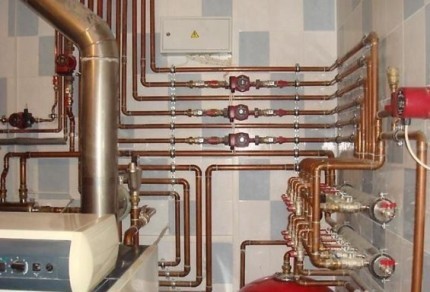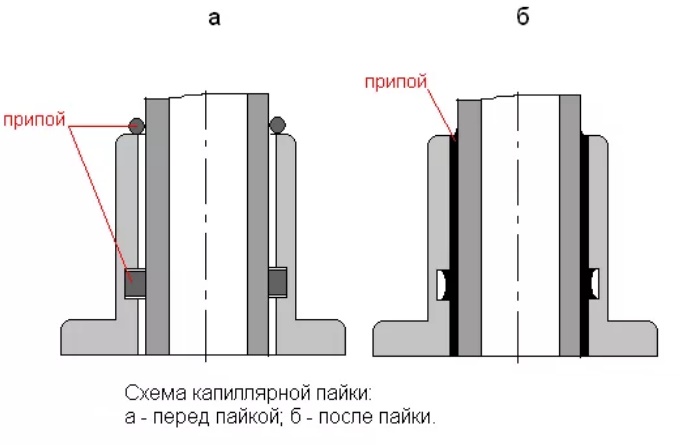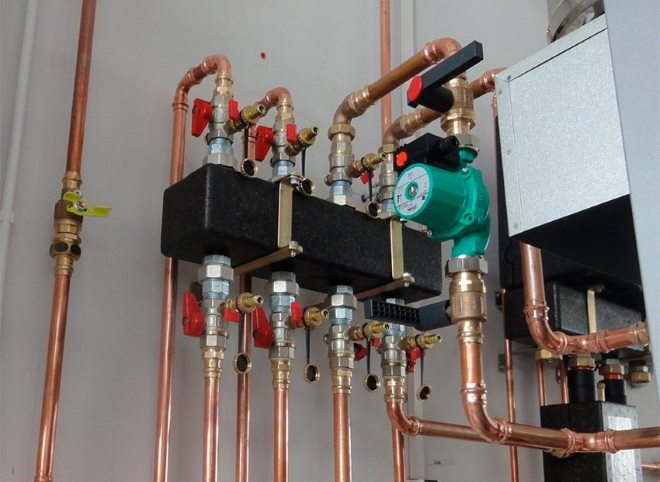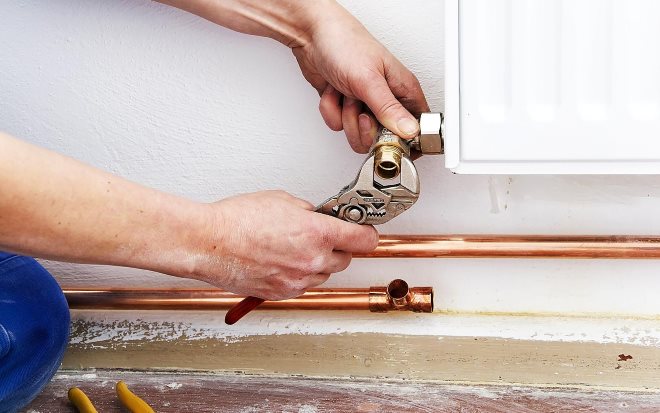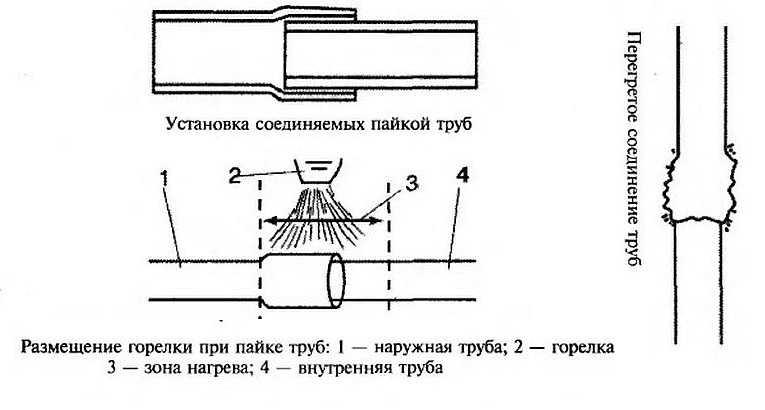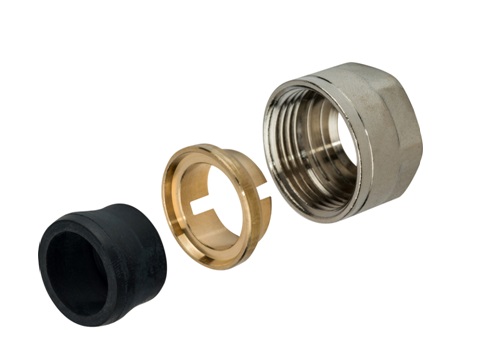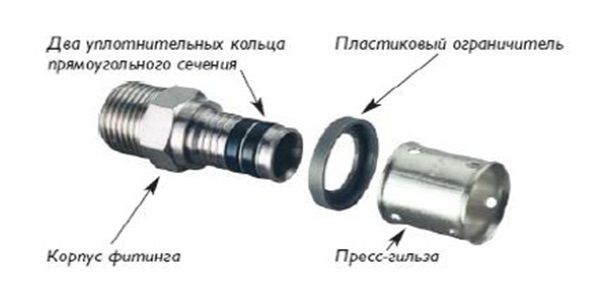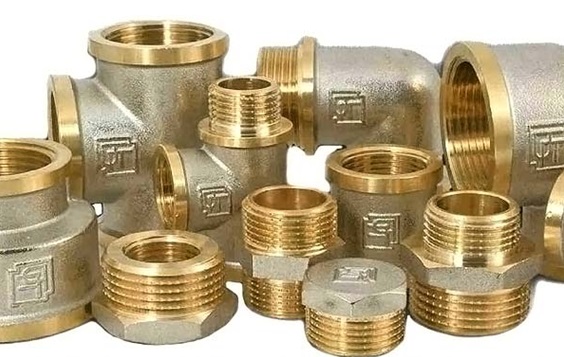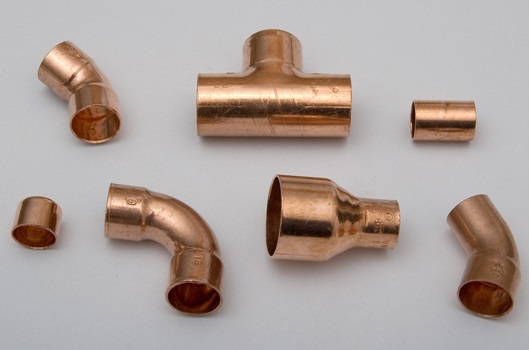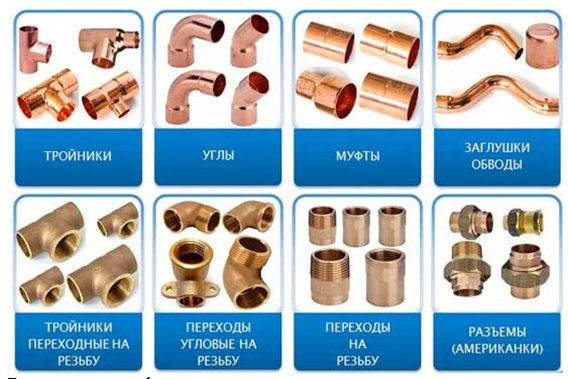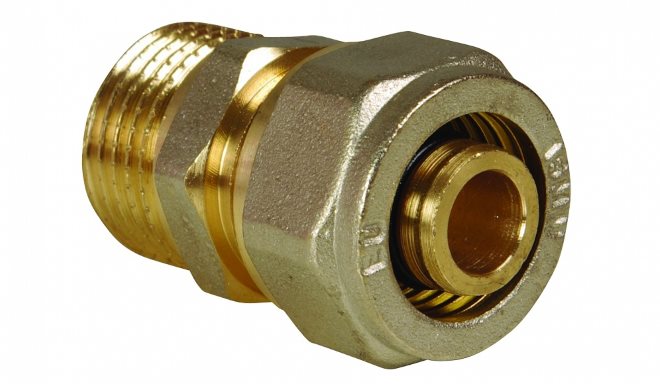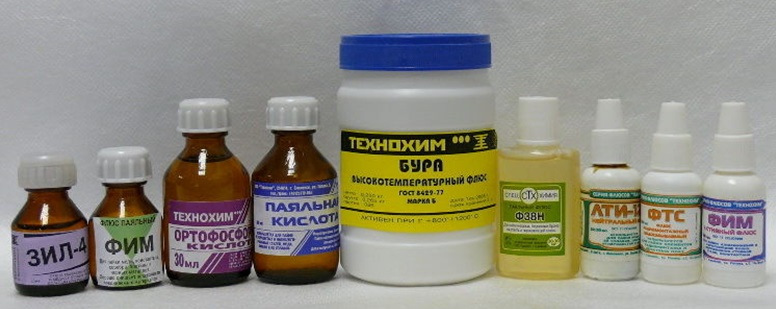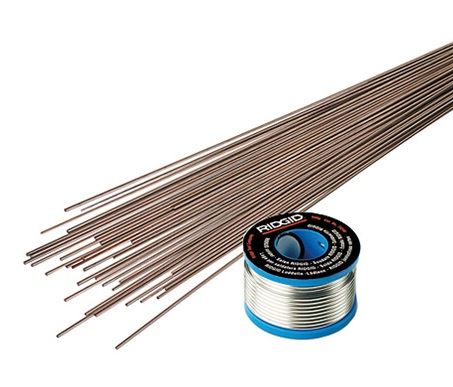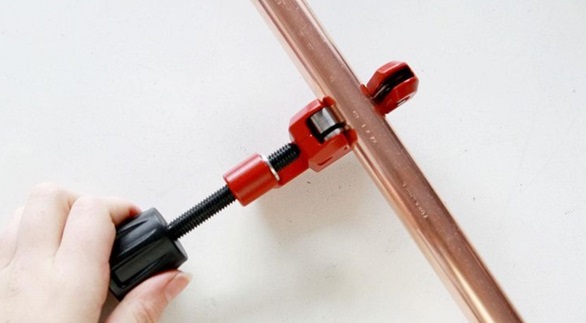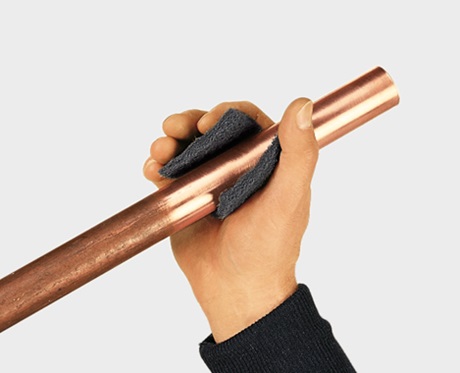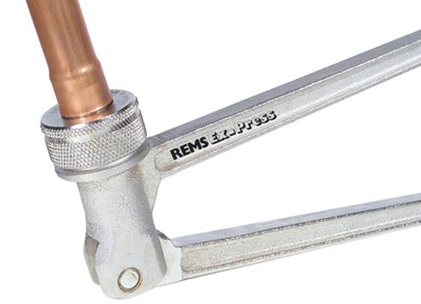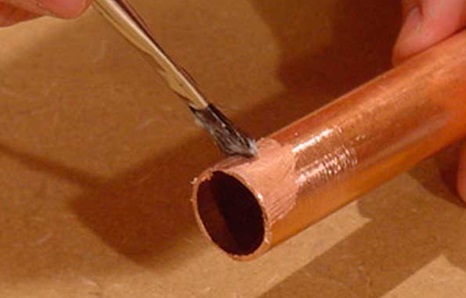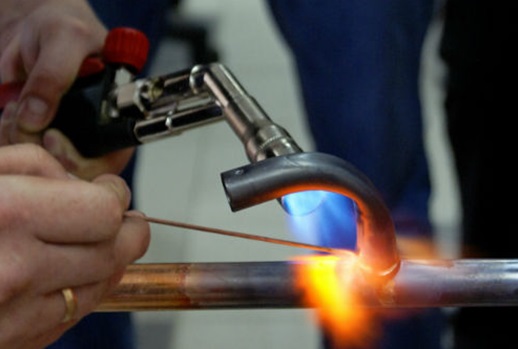Choice of mounting technique
In practice, two options for installing a copper piping system are most often used. Before starting work, everyone decides for himself which pipeline will be: detachable or one-piece.
There are the following connection methods:
- welding using an electric machine,
- by pressing,
- using a gas burner or an electric soldering iron.
All methods are allowed to be selected in production, regardless of the type of pipeline. The main thing is to decide whether fittings will be additionally used or not. If the system needs to be light and accessible in terms of repair work or adding additional elements, it is advisable to make the pipeline split. Fitting can be choose:
- compression,
- threaded,
- with automatic lock.
For self-creation, this is the best option, there is no need to use soldering. It is not necessary to have extensive experience or knowledge to make a collapsible system on your own at home. Periodically, you will have to tighten the nuts to avoid leaks. Constant adjustment of the pressure leads to a decrease in the strength of the fasteners.
Three main connection methods
Before connecting the pieces of copper pipes, they must be cut in accordance with the wiring diagram and prepared. You will need a pipe cutter or a hacksaw, a pipe bender and a file. And for cleaning the ends, fine-grained sandpaper will not hurt either.
Only having a diagram of the future pipeline system in hand, you can calculate the required amount of consumables. It is necessary to decide in advance where and what diameter the pipes will be mounted. It is also necessary to clearly understand how many connecting elements are required for this.
Option #1: Copper Pipe Welding
Automated or manual welding of copper pipes requires electrodes and gas to create a protective atmosphere (nitrogen, argon or helium). You will also need a DC welding machine and, in some cases, a torch. The electrode can be graphite, tungsten, copper or carbon.
The main disadvantage of this installation technology is the significant differences in the characteristics of the resulting seam and pipe metal. They differ in chemical composition, internal structure, electrical and thermal conductivity. If the welding is not performed correctly, the joint may subsequently even disperse.
Due to the alloying of copper as a result of the action of the deoxidizer present in the electrode, the weld in many respects differs greatly from the base metal being welded.
Welding copper pipes can only be correctly connected by a qualified craftsman. This requires certain knowledge and skills.
This installation option has a lot of technological nuances. If you plan to do everything yourself, but there is no experience with a welding machine, then it is better to use a different connection method.
Option #2: Capillary soldering
In domestic conditions, copper pipes are rarely connected by plumbing welding. This is too complex, requiring specialized skills and time consuming. It is easier to use the method of capillary soldering using a gas burner or a blowtorch.
The technology of soldering copper pipes with solder is based on the capillary rise (leakage) of the latter after melting along the gap between two pressed metal planes
Soldering copper pipes happens:
- low-temperature - soft solders and a blowtorch are used;
- high-temperature - refractory alloys and a propane or acetylene torch are used.
These methods of soldering copper pipes do not have much difference in the end result. The connection in both cases is reliable and tensile.The seam with the high-temperature method is somewhat stronger. However, due to the high temperature of the gas jet from the burner, the risk of burning through the metal of the pipe wall increases.
Solders are used based on tin or lead with the addition of bismuth, selenium, copper and silver. However, if the pipes are soldered for a drinking water supply system, then it is better to refuse the lead version due to its toxicity.
Image Gallery
To implement low-temperature welding, it is not necessary to have special equipment and special skills of the performer. You can do it on your own
Communications from copper pipes and fittings
High-quality copper pipes and fittings, the technical and operational characteristics of which comply with the international standards ISO 9002, BS2 and DIN, are now produced by both foreign and domestic companies. Such pipes, as well as connecting elements for them, successfully withstand the high pressure of the media transported through them, high and low temperatures, and mechanical stresses that they may be subjected to during operation, transportation and storage.
Unlike polymer pipes popular in our time, copper pipe products do not deteriorate from exposure to sunlight, they are not afraid of corrosion, which is a real scourge for products made from ferrous metals. In terms of the service life that copper pipes and fittings differ in, no similar product made from another material can be compared with them. It is noteworthy that copper products are practically eternal, the service life of communications from them is at least 100 years.
Heating and water supply system from copper pipes in a private house
Pipe products, as well as fittings made of copper, are used for arranging engineering networks for various purposes:
- heating systems;
- air conditioning;
- cold and hot water supply;
- gas communications.
Those consumers who decide to use copper pipe products and copper fittings mainly use them to equip reliable and durable water supply networks. Fittings made from copper are more compact and look much cleaner than those made from ferrous metals. This is explained by the fact that when designing and manufacturing copper fittings, there is no need to make their walls thicker, taking into account their further corrosion, since they are simply not subject to it.
Do-it-yourself installation of copper pipes in the heating system
There are several reasons explaining the high popularity of pipes and fittings for them made of copper:
- copper, as you know, has antiseptic properties, therefore, pathogens do not develop in water pipes made from this metal, and the quality of the water transported through them even improves;
- installation of pipelines for which pipes and fittings made of copper are used is much easier than communications from black pipes;
- due to the high plasticity of copper, pipes made of this metal, when water freezes in them, do not burst, but simply deform; to destroy a copper pipe, it is necessary to apply an internal pressure of 200 atm to it, and such pressures simply do not exist in household communications.
Soldering copper pipes
Soldering is carried out due to adhesion between molten copper-phosphorus or silver solders and heated pipes to be joined. The solder is distributed at the junction under the action of capillary forces, "wetting" the base metal. To improve the quality of soldering and increase the adhesion coefficient, special fluxes are used, and the soldering surfaces are pre-cleaned. When soldering, it is necessary to evenly heat the parts to be joined to the required temperature.
Therefore, when soldering, the type of burner flame is important, which indicates the balance of the gas mixture.A decreasing burner flame indicates an excess amount of fuel in the mixture that exceeds the oxygen content. A supersaturated gas mixture, due to an excess of oxygen, forms a flame that oxidizes the surface of the metal. A sign of this phenomenon is a black coating on the metal. A balanced gas mixture, when burned, forms a flame that heats the metal without any other effect.
When working on soldering copper pipes, also note that:
- The application of flux promotes adhesion of the solder to the metal.
- The place of soldering is preliminarily serviced.
- For high-quality soldering, the necessary heating of the soldered parts is required.
- For soldering copper pipes, cleaning of the joint is required.
Copper soldering tools
For soldering copper, special soldering irons and gas burners are used.
When working with copper pipes, in addition to soldering and crimping, they have to be cut, bent, expanded, and beaded. Pipe bending to avoid wrinkling and flattening is performed using a lever pipe bender. Moreover, for pipes with a diameter of up to 15 mm, the bending radius must be at least 3.5 diameters. For pipes of large diameters, the bending radius must be at least 4 diameters. You can also cut pipes with a hacksaw, but it is best with a pipe cutter, which allows you to do this exactly at the mark and without distortions. After each revolution, it is necessary to tighten the cutting roller by tightening the set screw. Burrs appearing during the cutting process must be removed.
To ensure the insertion of the pipe into the pipe, special expander pliers and mandrels are used.
Types of fittings
All connecting fittings are divided into several types according to their functions:
- Straight - for direct connection of two pipes of the same diameter. Such fittings are called couplings, the body is usually in the form of a cylinder.
- Transitional - for direct connection of two pipes of different diameters. Adapters, or reducers, have a complex shape: two short cylinders of different sizes are connected by a truncated cone.
- Angled, or rotary, - for connecting identical pipes at an angle. Such fittings are called bends or corners, the body bending angle is from 15 to 90 degrees.
- Branching - to combine two or more streams or split one stream into several. Tee bodies have three branch pipes, the diameters of which may vary. Cross body housings consist of four or more nozzles connected at right angles.
- Sealing - for blocking free branch pipes. These shaped elements, called plugs, are a lid or stopper.
Many, in my opinion, erroneously, believe that copper pipes for installing plumbing or heating a house are quite expensive, and some that the century of copper for these purposes is a thing of the past
In this entry, we will try to prove to you that this is not so, precisely because copper is a fairly convenient material for mounting any structures, and if we take its durability into account, then it is indispensable in many cases and it is she who will be chosen by a zealous owner for his own home
If we compare copper with other materials from which plumbing and other communication pipes are made (for example, with plastic or), then its advantages are obvious. First of all, it is an unusually long service life: copper pipes and fittings often last as long as the building itself exists.
Copper is very ductile, which increases the safety of the water supply system and retains its properties over a wide temperature range (from -200 to +250 ° C), which makes the pipes resistant to freezing when filled with water.
Copper pipes are resistant to ultraviolet radiation (unlike plastic), have a low roughness coefficient, which allows them to be used in similar conditions
The copper pipeline is practically not affected by various types of viruses and bacteria, it is not afraid of oils, fats and various harmful substances. Even chlorine, which is inevitable for our water pipes, is not able to destroy a copper pipe, but, on the contrary, due to the formation of an oxide layer on its inner walls, chlorine helps to extend the life of the pipe.
Pipes
Water supply copper pipes of circular cross section are produced both in coils (25 and 50 m long) and in segments (rods of various lengths). The most commonly used pipes have diameters from 8 to 28 mm with a wall thickness of 1 mm. It is worth emphasizing that copper pipes due to thin walls are much lighter than steel pipes. They may be insulated.
Installation of copper pipes does not cause any particular difficulties, mainly due to the fact that they are well cut and bent. Copper pipes can be connected in two ways: detachable and one-piece. The second includes soldering, welding, crimping.
To connect pipes, connect to fittings, various fittings are used to existing water supply.
Fitting
There are a large number of varieties of connecting and transitional fittings. Examples of some are shown in photos 1-12. So, for soldering, not only ordinary and adapter couplings are used, but also various elbows, tees, crosses, contours, rolls and plugs. There are fittings with the transition of a soldered connection to a threaded one, for example, an “American” with a cone seal (15 × 1/2 ″). Threaded press fittings often use a ferrule, which, when the union nut is tightened, compresses the pipe, thereby sealing the connection.
Limitations when using copper pipes
Despite the many advantages that copper pipes have, there are certain limitations to their use. These limitations are due to the following characteristics of this metal.
Copper is a very soft and ductile metal, so the fluid flow rate through pipes made of this material should not exceed 2 m / s. If the water that flows through water supply systems contains solid particles of contaminants that mechanically affect the pipe walls, this can cause gradual washing out of the metal (erosion) and a significant reduction in the life of the plumbing.
That is why, in order to ensure the reliable operation of copper pipelines, it is necessary that the water for them undergo preliminary purification from impurities. The oxide film that forms on the inner walls of copper pipes and provides them with even more reliable protection can form only when the hardness of the water in contact with them is 1.42–3.42 mg/l, and pH is 6.0–9.0. If this requirement is neglected, then the oxide film (patina) on the surface of copper pipes will be constantly destroyed and restored, which will eventually lead to a gradual decrease in the thickness of their walls and premature wear. If the water transported through copper pipes will be further used in food purposes or for drinking, then lead-based solders should not be used for their installation. Considering the fact that the average life of copper water pipes is 50 years, they should be installed in such a way as not to reduce it in any way. So, it is not allowed: to twist the pipes, to make creases when they are bent, to edit jams on them more than once.
Fittings for copper pipes
- When soldering pipes and copper fittings, it is necessary to monitor their heating temperature, since overheating can lead to a decrease in the strength of the material and its rupture at the junction. After soldering copper pipes and installing fittings, it is necessary to remove the used flux from the inside of the water supply system, for which the flushing method is used .Such a flux, being a chemically aggressive substance, can lead to the development of corrosion processes in the pipeline. processes. If the use of such elements is necessary, then passive anodes attached to the system will help prevent their corrosion. Fittings that are used to connect a copper pipe to a water supply element made of another metal should be made of brass, bronze or stainless steel, this will avoid corrosion elements.
However, even these limitations, which can be considered insignificant, do not reduce the popularity of copper pipes, which are considered the best material for arranging water supply systems.
https://youtube.com/watch?v=7Wim2hDl1FUrel%3D0%26controls%3D0%26showinfo%3D0
- www.ocm.ru
- tubepro.ru
- www.trubygid.ru
- met-all.org
Types of copper fittings
A variety of types of copper fittings allows you to complete the pipeline of any configuration. Depending on the connection method, there are:
- threaded parts that can be dismantled repeatedly;
- compression or compression fittings - a variant of collapsible parts for pipe installation even in the most inaccessible places. Consist of a ring and a nut that fixes the joint from the outside;
- press fittings - parts for the assembly of pipelines made of copper and polymers;
- parts for soldering;
- self-locking connecting elements - modern types of parts, consisting of a spring-loaded clamping mechanism with a seal, which is closed with a key, are quite comparable with soldering in terms of tightness and strength of the connection, while it remains possible to dismantle the assembly.
Copper fittings have a diameter of 6-108 mm and can be:
- connecting - these are drives, couplings, fittings and adapters;
- changing direction - elbows and bends;
- separating - tees and crosses, which create several branches from one pipe and direct them in different directions.
Selection of fittings
When choosing fittings for organizing a pipeline for a heating, plumbing or other other system, the following factors must be considered:
- device type;
- purpose and dimensions of the connecting element.
Types of fittings
The following types of fittings are used to connect copper pipes:
- compression;
- crimp;
- threaded;
- soldered.
Compression fittings allow you to get a detachable connection. Devices consist of the following elements:
- body, which can be made directly from copper or other metals: brass, bronze, and so on;
- a clamping ring that gives the connection tightness;
- cap nut, with which the connection is fixed.
Reusable connector
The advantages of using compression fittings are:
- ease of installation. To assemble the pipeline with these elements, special equipment and additional skills are not required. Besides installation of a fitting is made in the shortest possible time;
- low cost of the fitting, especially if devices made of brass are used;
- the possibility of repair work without replacement.
Among the most significant disadvantages of fittings of this type are:
- the impossibility of installation on pipelines of a hidden type. Due to the low level of tightness of the connection and the need for constant tightening of the union nut, it is recommended to install compression fittings exclusively on external pipelines;
- the impossibility of using on pipelines intended for carrying gas and liquids under high pressure (the reason is the low level of tightness of the connection).
When using a compression type connector several times, the level of reliability is significantly reduced.
Crimp fittings allow you to get a stronger and tighter connection, which greatly expands the scope of their use. Crimp or press fitting consists of:
- corps;
- rubber sealing ring, which increases tightness;
- limiter, which is most often made of plastic;
- press sleeve required for fastening.
Pipeline element for obtaining a tight connection
The benefits of crimp fittings include:
- obtaining the most tight joint in the shortest possible time;
- low cost;
- Possibility of installation both in ground and hidden pipelines.
The only significant disadvantage of press fittings is the complexity of installation, since special equipment is required to install this type of elements.
The simplest connecting elements for the pipeline
Threaded fittings are the simplest connecting elements, consisting of a body, at the ends of which an internal or external thread is cut.
To seal the connection, different seals are used: linen thread, FUM tape, and so on.
Copper pipe fittings intended for soldering are used extremely rarely, for example, for bending a pipeline or connecting an additional outlet. Such a fitting consists of a body, and its installation requires a gas burner.
Solder Mounted Devices
Currently, compression or press fittings are the most popular when assembling copper pipelines.
Purpose and dimensions of fittings
After choosing the type of connecting fitting, it is necessary to determine the purpose of the device and its overall dimensions.
By appointment, all fittings are divided into the following types:
- taps. Used when it is necessary to change the angle of passage of the pipeline for heating, water supply, and so on;
- tees, which are installed if it is necessary to connect an additional line to the pipeline;
- crosses. The main difference from tees is the presence of an additional inlet / outlet;
- line fittings. They are mainly used to increase the length of the pipeline by attaching an additional cut;
- plugs. Allow to block the supply of the substance passing in the pipeline in a certain area.
Types of fittings depending on the purpose
The choice of the type of fitting is carried out in accordance with the developed pipeline scheme.
When choosing a connecting node for water supply, gas pipelines, heating systems, and so on, it is also necessary to take into account the dimensions of the fittings. The diameter of the connecting element must be equal to the diameter of the pipes used to organize the pipeline. If a threaded fitting is installed, then the dimensions (pitch) of the thread must also be determined.
How to connect copper pipes - construction
How to connect copper pipes
Copper pipes are connected when arranging various pipelines, using fittings and special methods. Everyone needs to know how to connect copper pipes, since obtaining a reliable joint requires certain conditions to be met.
Flare connection
Soft copper pipes are very often connected to a coupling in which the non-flared end of the pipe is sealed. It is not difficult to dismantle such a joint, and then it can be easily restored. Usually, a flared connection of copper pipes is used when it is dangerous to work with a burner and it is impossible to completely drain the water from the old pipe. The order of work is as follows:
1. Clean the end of the pipe. In this case, you need to remove all the burrs.
2. Put the coupling on the pipe.
3. Insert the pipe into the calibrated flare hole. Squeeze it in there well.The hole should be the same diameter as the pipe itself. Install the end of the pipe at the same level or slightly above the clamping surface.
4. Put a fixture on the clamp. Start turning the screw until the cone flares at an angle of approximately 45 degrees to the end of the pipe.
5. Remove the pipe from the calibrated hole. Then you need to bring the coupling close to the flared edges. Wrap the threads of the coupling with sealing tape, and tighten the nut.
Connection with fittings
Connecting copper pipes with fittings reduces labor costs during installation, the time it takes to complete the work and guarantees the quality of the connection, since there is no metal retraction. Copper pipes with fittings are most often connected by capillary soldering, which is based on the capillary effect. There are two types of soldering copper pipes:
The soldering is high-temperature. For this method, rod refractory solders are used. Propane and acetylene burners are used to heat pipes;
The soldering is low-temperature. With this method, soft solders are used, which are rolled into coils. For this soldering, fire from an ordinary blowtorch is enough.
There are no special differences in these two methods, but high-temperature soldering is used for socket pipe connections, and low-temperature soldering is used on joints with fittings into which solder is fused.
The fitting method is as follows:
A fitting is put on a flux-coated pipe:
The joint is heated with a torch until the solder melts and closes the gap between the fitting and the pipe;
The structure is allowed to cool and then the exterior is cleaned with special cleaners for copper. After that, the pipe is ready for operation.
Threaded connection
The threaded connection of copper pipes is collapsible, and special ferrules are used. If there is a need for dismantling, the ring will need to be replaced. This type of connection is made as follows:
First cut off a piece of pipe of the required length;
If pipes with PVC insulation are used, it is necessary to remove the insulating layer from the end of the pipe with a sharp knife and remove the burrs that formed after the cut with a file;
Fitting is being prepared;
A union nut is put on the pipe, then a squeeze ring is put on;
The nut should be screwed on smoothly - at first it is twisted by hand, when it becomes impossible to do so, a key is used. During operation, the nut compresses the pipe and the joint is sealed.
fix-builder.ru
In order to carry out the correct installation of hot and cold water supply, gas supply or air conditioning, it is necessary to familiarize yourself with the rules and methods of connection in a copper pipe system. The high cost is justified by high technical characteristics and a long service life.
Fig 1. Working with a special burner
Connectors of compression and self-locking type
Fittings for connecting copper pipes, belonging to the category of compression or self-locking, are also called collet or crimp. Such connectors are a good alternative to fittings that are connected to copper parts by soldering. A collet-type fitting is an element whose design consists of sealing rings and gaskets, as well as a crimp ring, which, when tightened, contributes to the tightness of the created connection. The material for the manufacture of compression or collet fittings can be not only copper, but also brass or metal-plastic.
Brass push-in fitting with male thread
Crimp type collet fittings are the best option for heating and plumbing systems, for the installation of which copper pipes of different diameters or tubular products made of various materials are used.Recently, self-locking fittings have become increasingly popular, which are distinguished by more preferable performance characteristics.
Self-locking fittings, in terms of the speed of making the connection and in terms of its reliability, can completely replace soldering. The design of such fittings includes a whole set of rings, one of which is equipped with special teeth. The principle of operation of such connecting elements is based on the fact that when exposed to a ring with teeth using a special assembly key, it is fixed in an adjacent element, thereby creating a reliable and durable connection of copper pipe sections. Unlike soldering, dismantling the connection obtained with such a fitting is as simple as obtaining it, for this the same installation key is used.
Assembly of a copper pipeline by soldering
The greatest tightness can be achieved if the pipes are connected by soldering. When performing work, it is necessary to strictly observe the recommended safety rules.
Tools
To assemble the pipeline by soldering, you will need the following set of materials and tools:
- copper pipes, the number and diameter of which is determined according to the scheme;
- pipe cutter (in the absence of a device, you can use a conventional hacksaw);
- pipe bender;
- a metal brush for preparing pipes for soldering;
- sandpaper (used in addition to the brush);
- pipe expander - a special device for increasing the diameter of one of the connected pipes;
- gas-burner;
- beveler (device for removing burrs after cutting pipes);
- flux composition, which allows for additional cleaning of pipes and contributes to a more uniform distribution of solder;
Varieties of flux for soldering
solder - a metal alloy that fills the space between pipes during the soldering process.
Varieties of solder for different types of soldering
Flux and solder are selected depending on the type of soldering (low-temperature or high-temperature), and the flux and solder should match each other as much as possible.
soldering process
How to connect copper pipes by soldering? To obtain a strong connection, it is recommended to adhere to the following scheme:
- pipes are cut. The length of each section of the pipeline must correspond to the scheme, which indicates the copper piping in the living quarters;
Cutting pipes with a pipe cutter
- chamfer is removed from the ends of the pipes. Then the soldering areas are cleaned to achieve the most even surface and cleaned of oxides and other contaminants with a metal brush;
Preparing the pipe surface for soldering
- to achieve maximum tightness of the solder joint, the end of one pipe must be expanded by 2 mm - 3 mm;
Increasing the pipe diameter
- the place of future soldering is treated with flux. Since the chemical composition can adversely affect the skin of the hands, work is done with protective gloves. Flux in the form of a paste is most conveniently applied with a small brush;
Applying flux to a section of pipe
- the burner heats up to the desired operating temperature;
- the flux melts a little;
- pipes are connected;
- excess flux is removed with a dry soft cloth;
- soldering is performed. Solder is smoothly applied to the heated area, which, when heated, melts and fills all the free space;
Filling with solder during the soldering process
- for 3 - 5 minutes (until complete cooling), the connection is left stationary;
- the next section of the pipeline is connected in the same way.
The soldering of pipes is carried out at high temperature. In addition, harmful substances are often released during the performance of work. Therefore, the assembly of the pipeline by soldering must be carried out in a well-ventilated area and away from flammable substances or objects.
Possible ways to install copper pipes are discussed in detail in the video.
After pre-assembly, copper pipes are laid according to a previously developed scheme. To fix the pipeline, you can use a clamp, bracket or other devices. In addition, pipes can be laid in the walls.
Soldering methods
There are two ways to connect by soldering:
- Low-temperature soldering, which involves heating the joint to + 250-300 ° C using a gas mixture (propane - butane), standard flux and low-temperature soft solder.
- High-temperature soldering uses a heating temperature of more than + 650 ° C, a gas mixture (propane - oxygen or acetylene - oxygen), high-temperature flux and hard solder.
Low-temperature soldering is used to connect pipes in domestic systems. Even a person who does not have special knowledge and skills can make such a docking.
The high temperature method is characterized by increased strength. Pipes connected under the influence of high temperatures are capable of working under high pressure, and can be used to transport gas or hazardous liquids. Soldering requires the use of professional equipment, so it is usually used in industries.
There is a fundamental difference in the technological process of low-temperature and high-temperature soldering:
- In the first case, the joint heats up and the solder melts from the heated metal, which must be kept at the bottom of the joint.
- In high-temperature soldering, the solder is preheated, after which the joint is heated together with it until the solder fills the groove prepared for it. High temperature allows you to do this instantly, excessive overheating of copper adversely affects its performance and weakens the strength of the connection.
